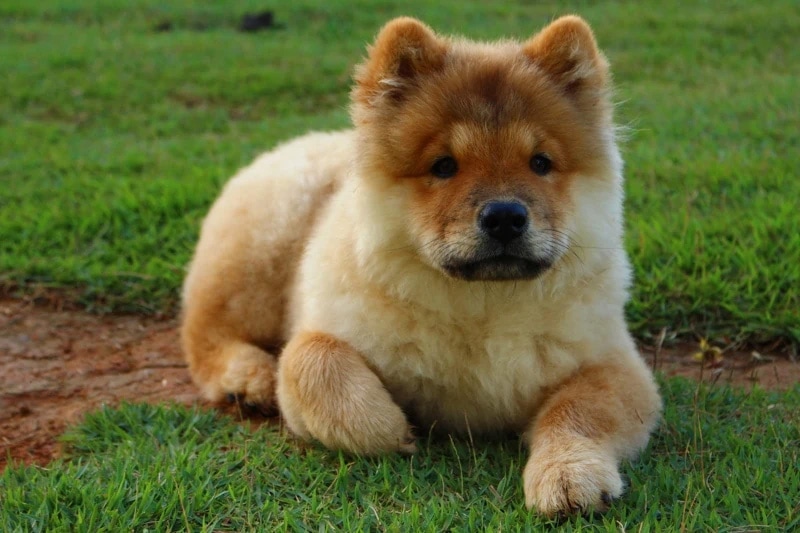Have you ever wondered why your furry friend curls up and tucks their paws under their body while lounging or sleeping? It’s a common and adorable behavior seen in many dogs, but what exactly is the reason behind it?
Here, we will explore the behavior of paw tucking and uncover 12 reasons why dogs exhibit this fascinating position. If you’re curious about your dog’s paw tucking, read on to find out more!

What Is Paw Tucking?
Before looking into the reasons behind paw tucking, we first need to understand what it actually is. Paw tucking refers to the act of a dog curling up their paws underneath their body while resting, sleeping, or even when awake.
This behavior can vary in intensity, from a slight tuck to a full wrap where the paws are tucked tightly against the body. Now, let’s explore the intriguing reasons why dogs adopt this position.


The 12 Reasons Dogs Tuck Their Paws
1. Comfort and Coziness
One of the primary reasons dogs tuck their paws is to find comfort and create a cozy space for themselves. By curling up and tucking their paws close to their body, dogs create a warm and secure environment. This behavior is reminiscent of their days as puppies when they used to snuggle close to their littermates for warmth and comfort.
2. Security and Contentment
Tucking their paws under their body also provides dogs with a sense of security and contentment. By keeping their paws hidden, they feel protected and shielded from potential threats. It’s their way of saying, “I feel safe and at ease in my surroundings.”

3. Temperature Regulation
Dogs are remarkable at regulating their body temperature, and paw tucking plays a role in this process. By tucking their paws, dogs minimize the exposed surface area, helping to conserve body heat during colder temperatures. Conversely, in hot weather, dogs may tuck their paws to reduce contact with warm surfaces and keep cool.
4. Energy Conservation
Ever noticed your dog tucking their paws after a long play session or a vigorous walk? This behavior serves as a form of energy conservation. By curling up and tucking their paws, dogs conserve energy and promote rest and relaxation. It’s their way of recharging their batteries!

5. Muscle Relaxation
Tucking their paws under their body also helps dogs achieve muscle relaxation. Just like humans who curl up to find comfort and relieve tension, dogs adopt this position to release stress and unwind. It’s their natural way of achieving a state of calm and tranquility.
6. Nervousness and Submission
In some cases, dogs may tuck their paws as a response to nervousness or as a submissive gesture. When faced with unfamiliar or intimidating situations, dogs may instinctively adopt a more compact posture to convey their submissive nature and avoid conflict. It’s their way of saying, “I mean no harm, and I respect your authority.”

7. Distancing Themselves from Something
If your dog tucks their paws while being close to an object or person, it could indicate their desire to create some physical distance. By tucking their paws and pulling their body closer, dogs create a slight barrier between themselves and the nearby stimulus. It’s their way of maintaining a safe personal space.
8. Minimizing Body Exposure
When it’s chilly or windy, dogs might tuck their paws to minimize their body exposure and protect themselves from the elements. By huddling and tucking their paws, they reduce heat loss and shield themselves from cold air or gusts of wind. It’s their clever adaptation to cope with adverse weather conditions.

9. Alarmed and Alert Position
In certain situations, dogs tuck their paws as an instinctive response to heightened alertness. When they sense something out of the ordinary or potentially dangerous, they may assume a more compact posture to be ready for action. It’s their way of preparing themselves for any potential threat that might arise.
10. They Are Knuckling
Some dogs tuck their paws due to a condition called knuckling, where they have difficulty placing their paws correctly on the ground. Knuckling can occur due to various reasons, such as neurological issues or injuries. If you notice persistent paw tucking accompanied by abnormal gait or mobility problems, it’s important to consult a veterinarian for a proper diagnosis and treatment.
Did you know you can speak to a veterinarian without having to travel? Just head over to PangoVet. It's our online service where you can talk to a vet online and get the advice you need for your pet — all at an affordable price!

11. Typical Behavior in Some Breeds
Believe it or not, certain dog breeds are more inclined to tuck their paws than others. Breeds like Greyhounds, Whippets, and Italian Greyhounds, with their lean bodies and long limbs, often exhibit this behavior. Bulldogs are also inclined to tuck their paws due to their massive bodies. It’s their natural inclination, influenced by their anatomy and instinctive tendencies.
12. Developed and Habitual Behavior
For some dogs, paw tucking simply becomes a developed behavior over time. If they have found this position to be comfortable and soothing, they may continue to tuck their paws out of habit. It becomes their preferred way of resting, sleeping, or seeking solace.
Remember, each dog has their own unique personality and behaviors and paw tucking may just be one of them!


When Should I Stop My Dog from Tucking Their Paws?
In most cases, there is no need to intervene if your dog tucks their paws. It’s a natural behavior that brings them comfort and relaxation.
However, if you notice your dog persistently tucking their paws accompanied by signs of pain, discomfort, or mobility issues, it’s essential to consult with a veterinarian. They can assess your dog’s condition and provide appropriate guidance.
How to Prevent My Dog from Paw Tucking
Since paw tucking is a natural behavior for most dogs, it is not necessary to prevent or discourage it. Instead, focus on providing a comfortable and safe environment for your furry companion. Ensure they have a cozy bed or resting area where they can curl up and tuck their paws whenever they feel the need.
When Should I See a Veterinarian?
While paw tucking is generally harmless, there are instances when it warrants veterinary attention. If your dog displays signs of discomfort, pain, abnormal gait, or persistent paw tucking that interferes with their daily activities, it’s crucial to schedule a visit with a veterinarian. They can conduct a thorough examination and perform any necessary diagnostic tests to identify and address any underlying health issues.


Conclusion
The adorable habit of paw tucking in dogs is a delightful behavior that serves various purposes. From finding comfort and coziness to temperature regulation and muscle relaxation, dogs have their reasons for curling up and tucking their paws.
By understanding and appreciating this behavior, we can better meet the needs of our furry friends and provide them with the love and care they deserve. So, the next time you catch your dog tucking their paws, remember all the reasons behind this endearing gesture and embrace the unique traits that make our canine companions so special!
Related Reads:
Featured Image Credit: Ires003, Shutterstock



















